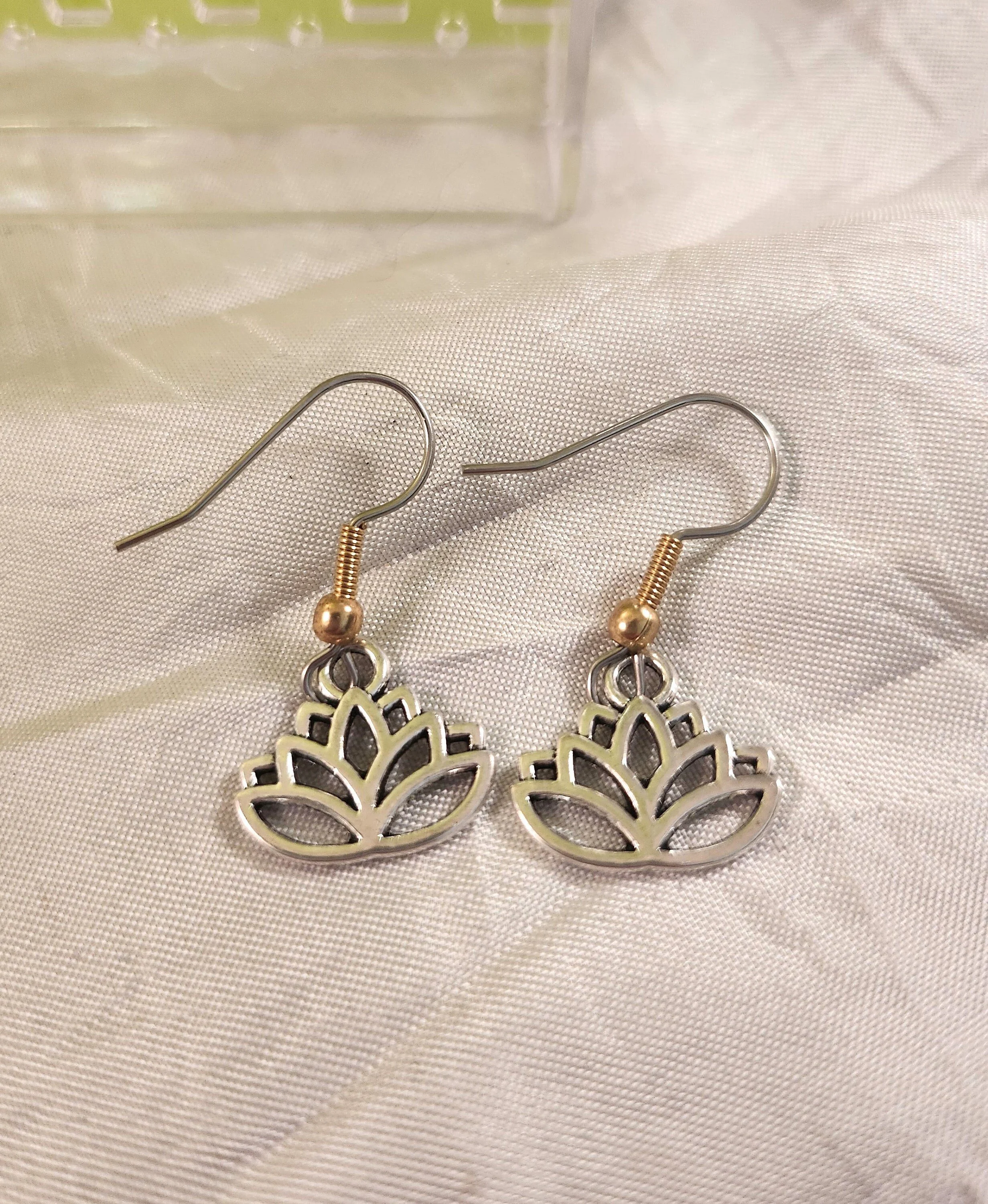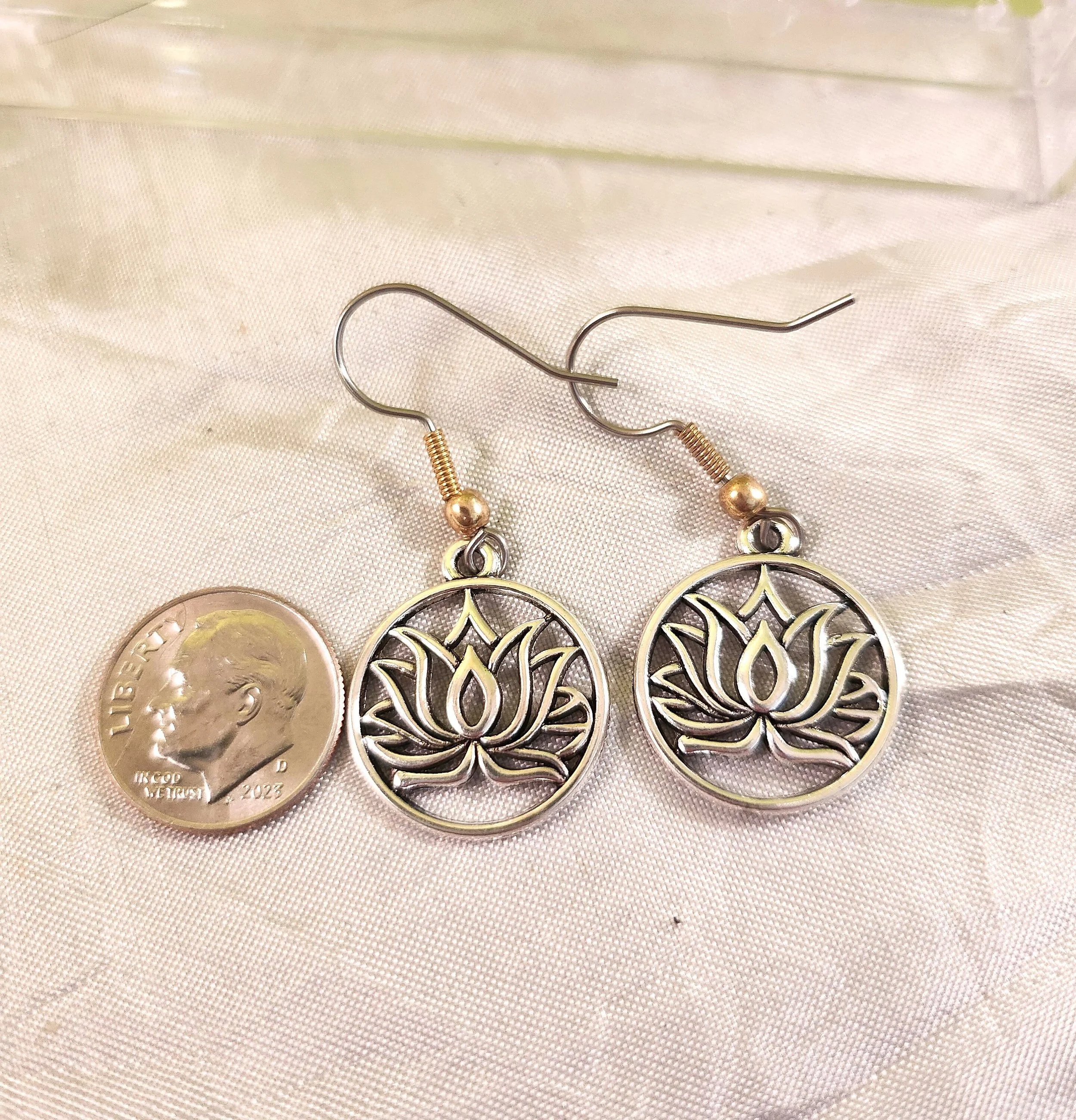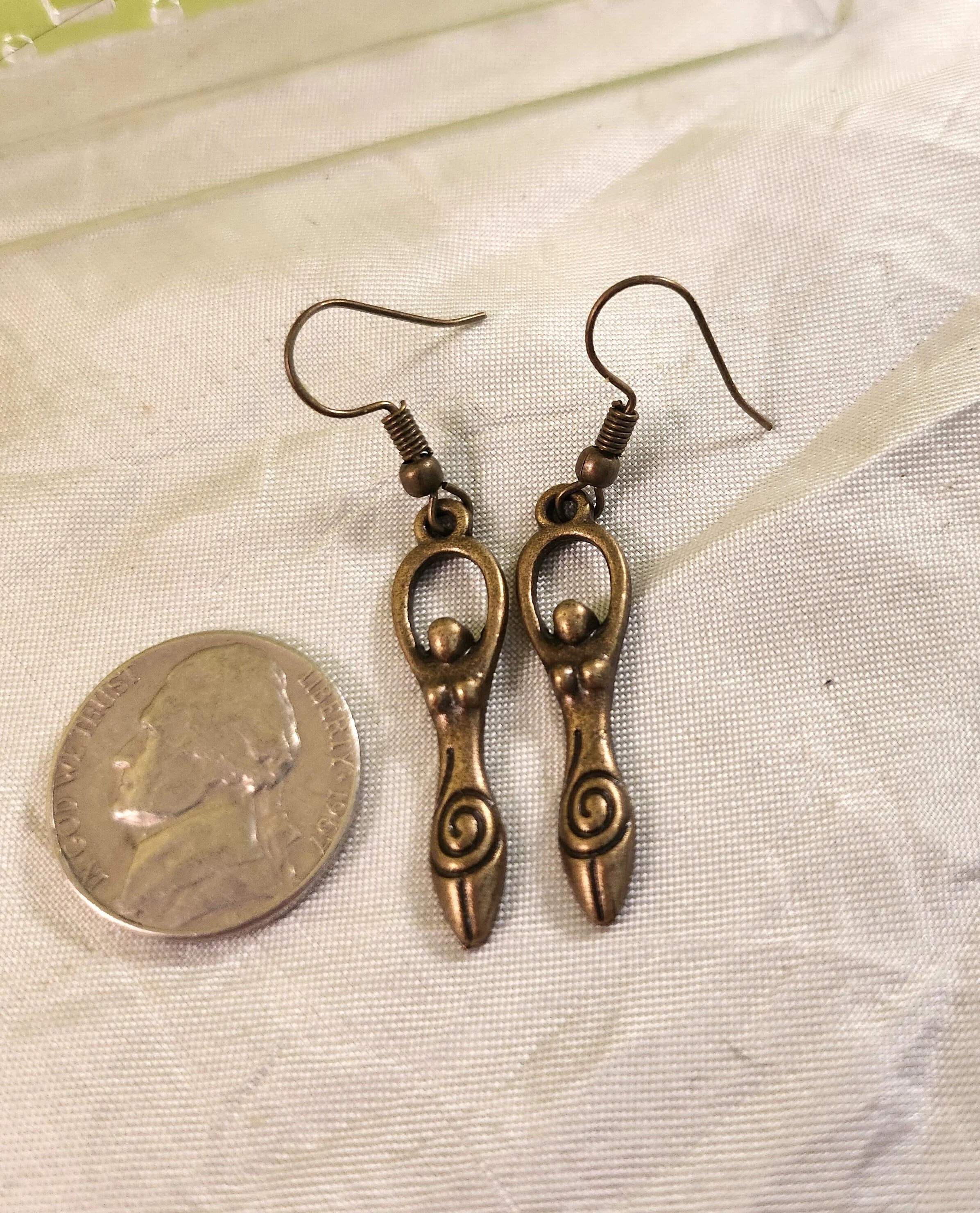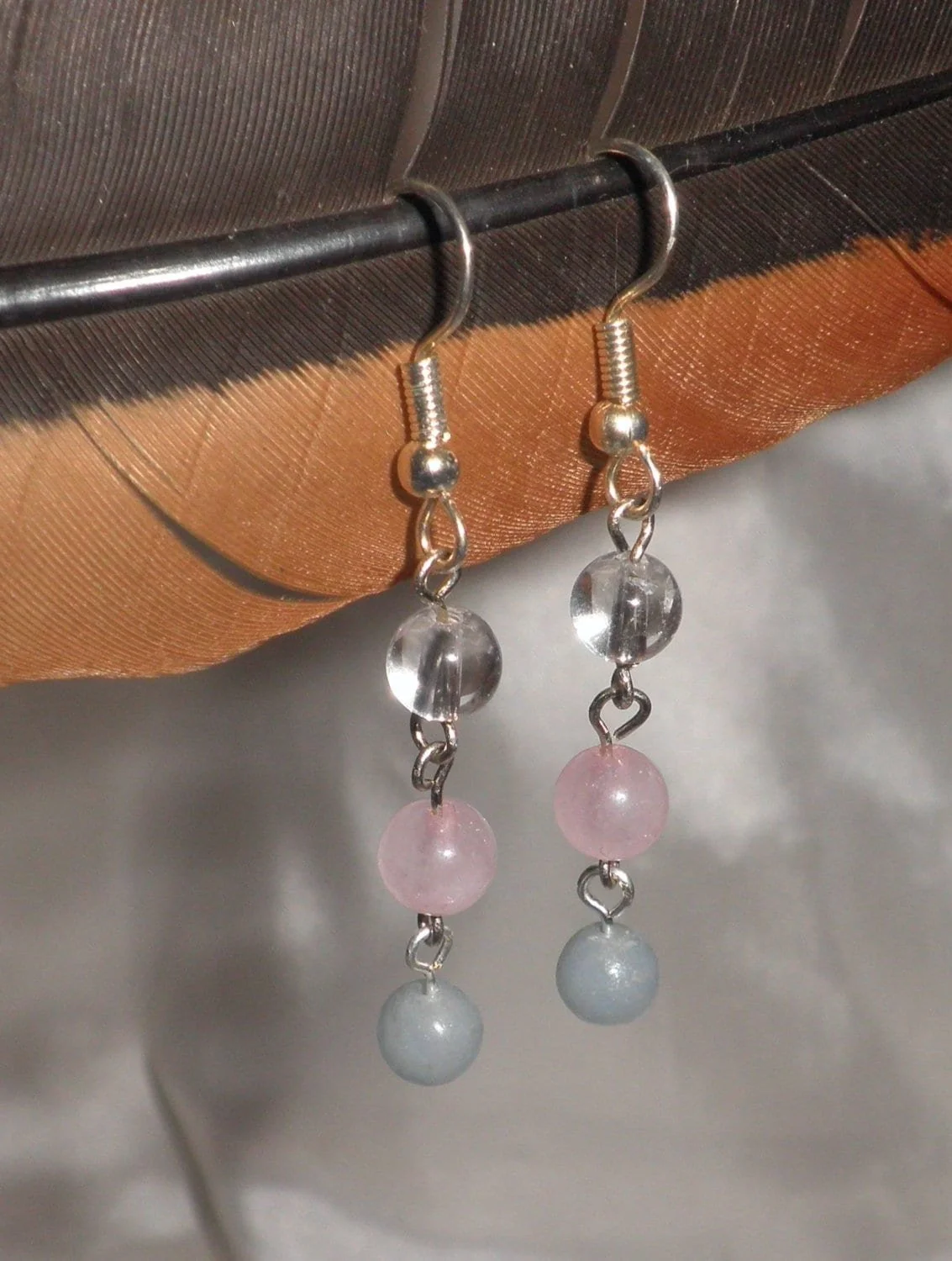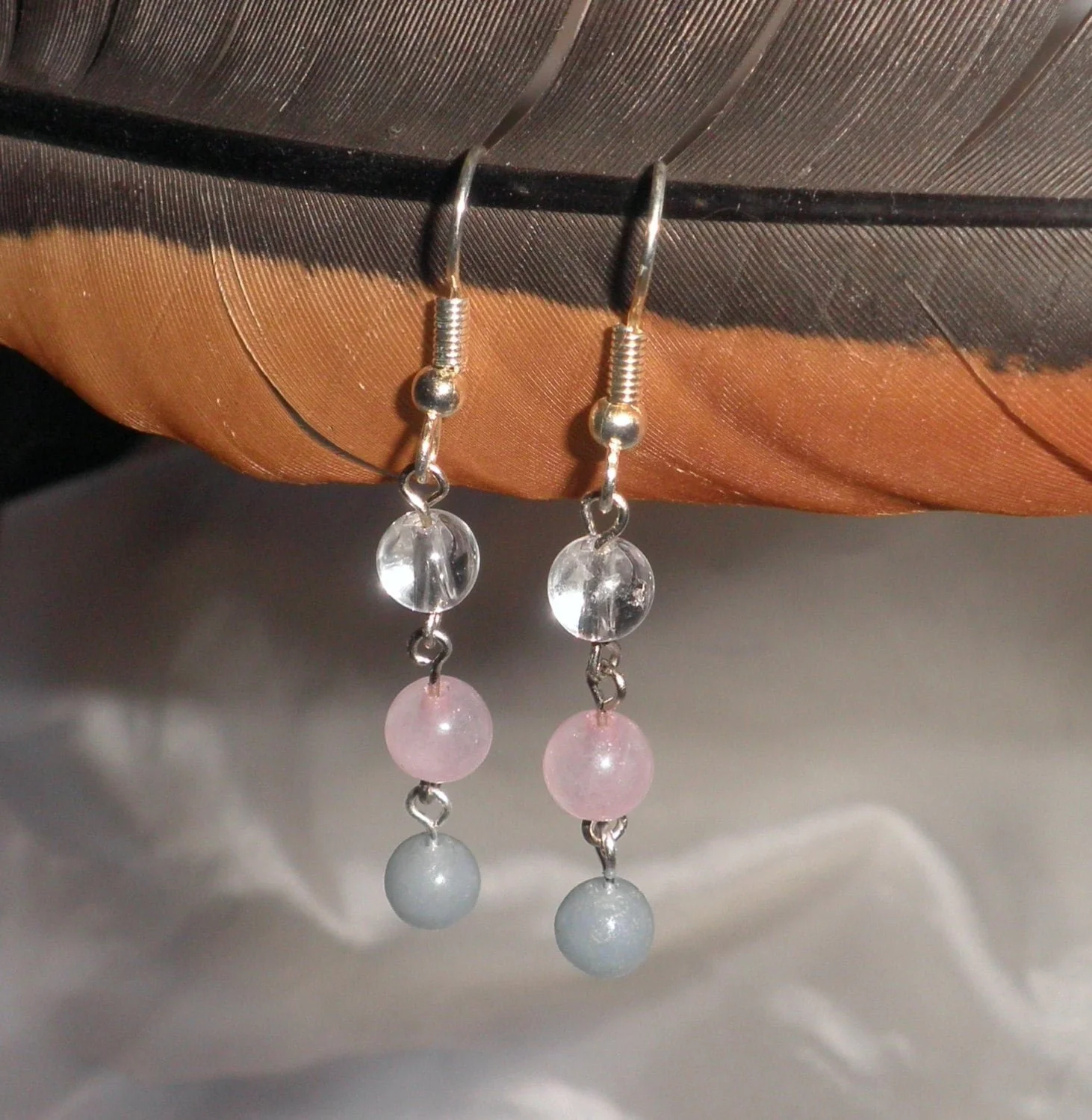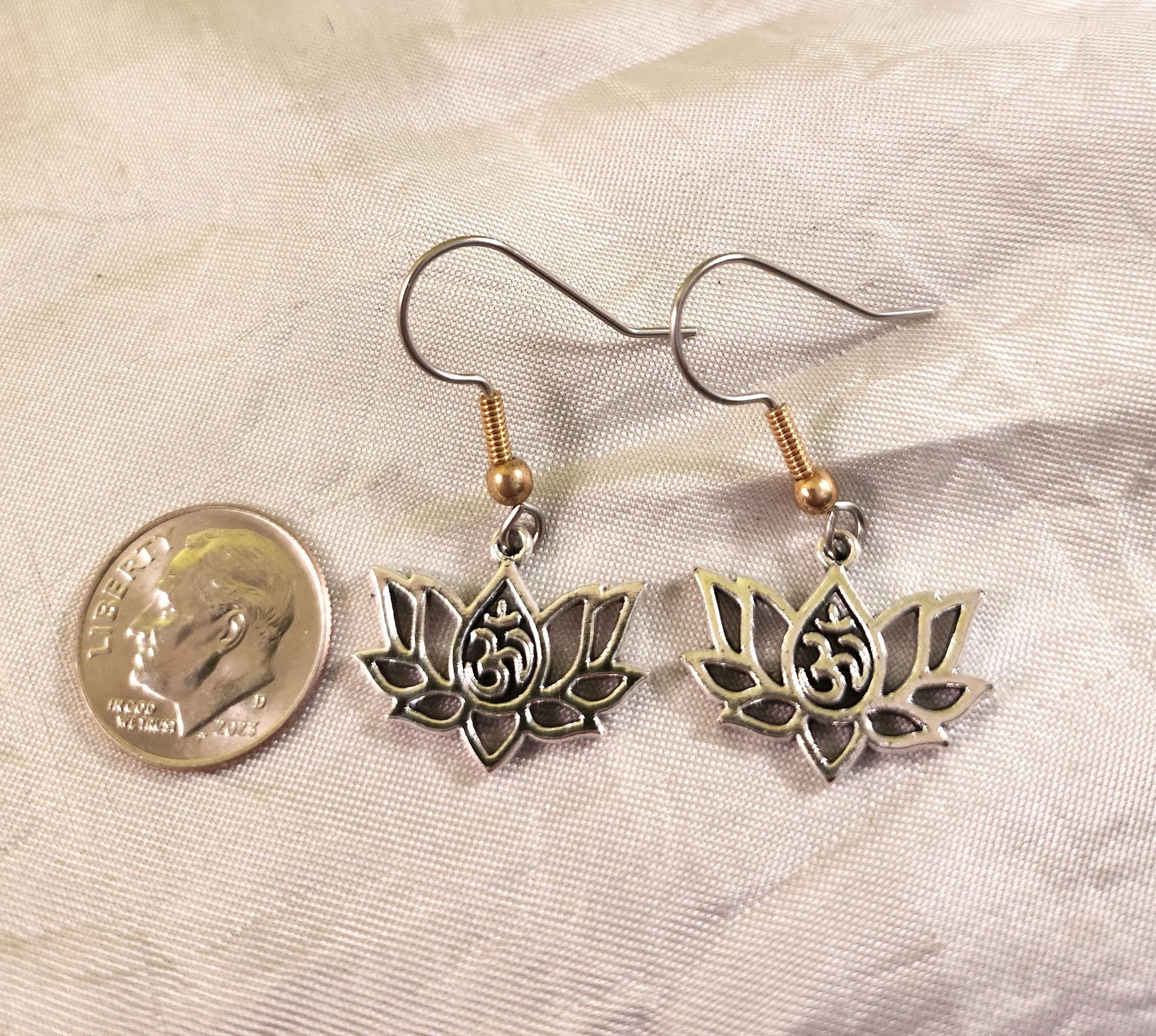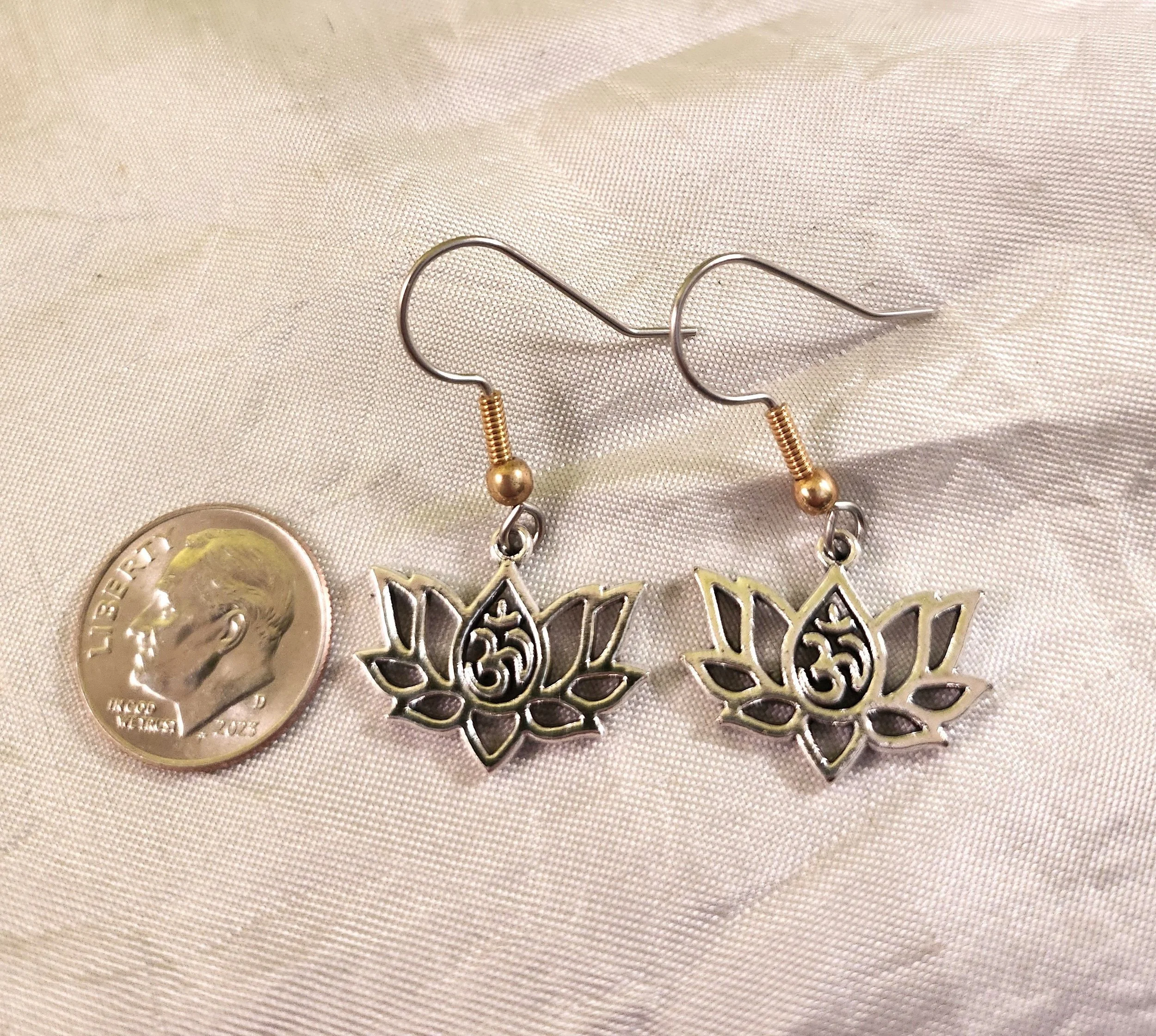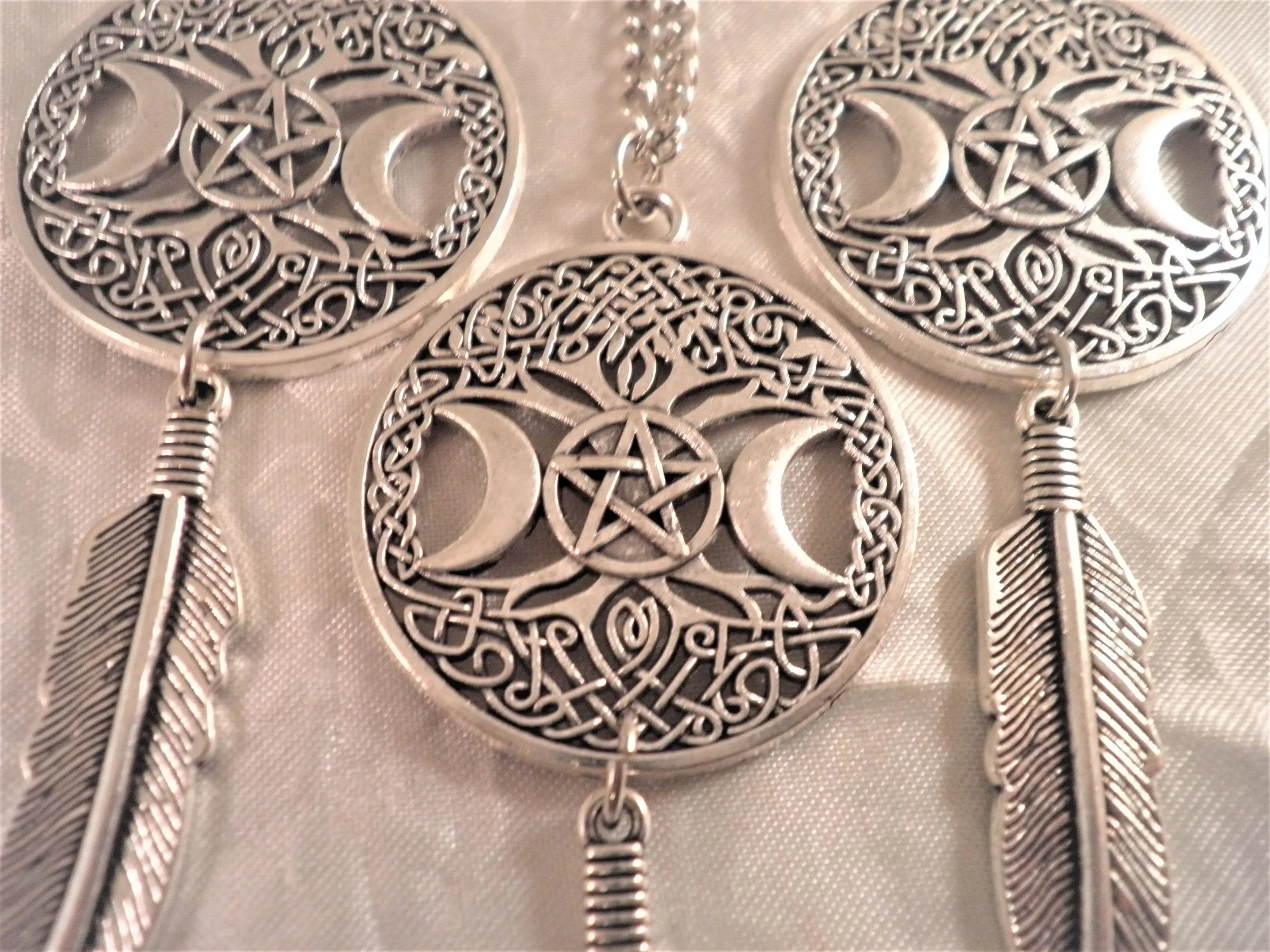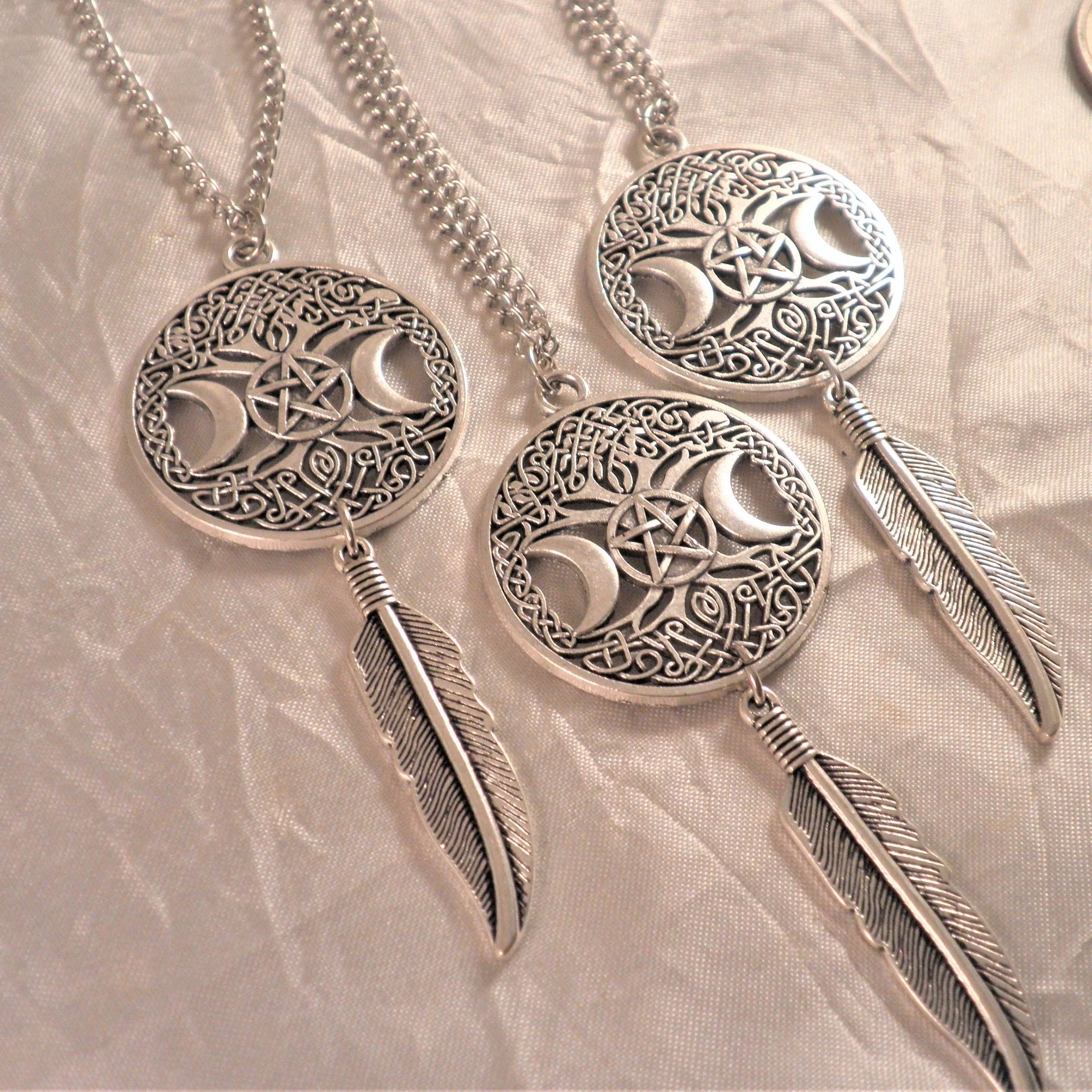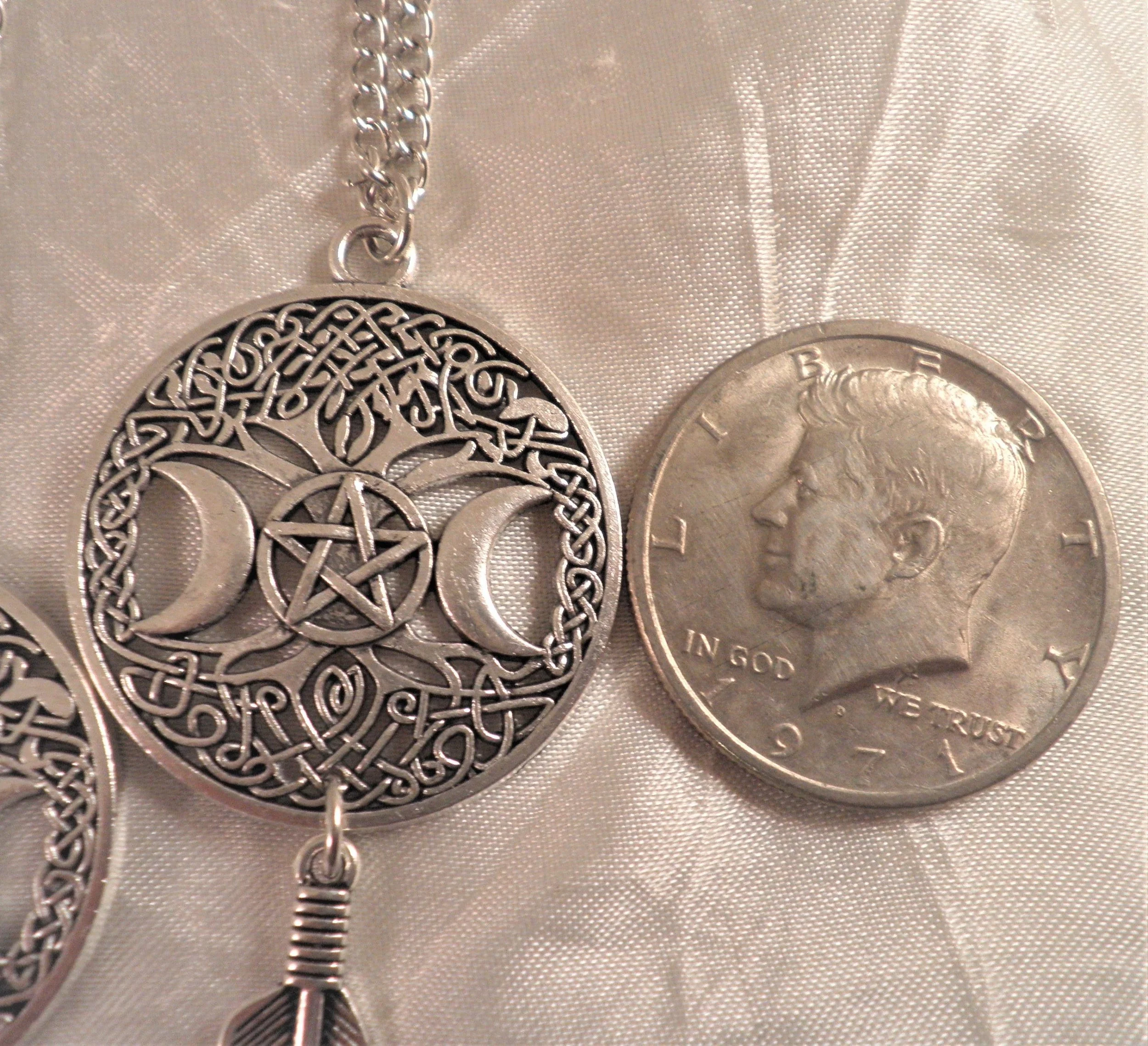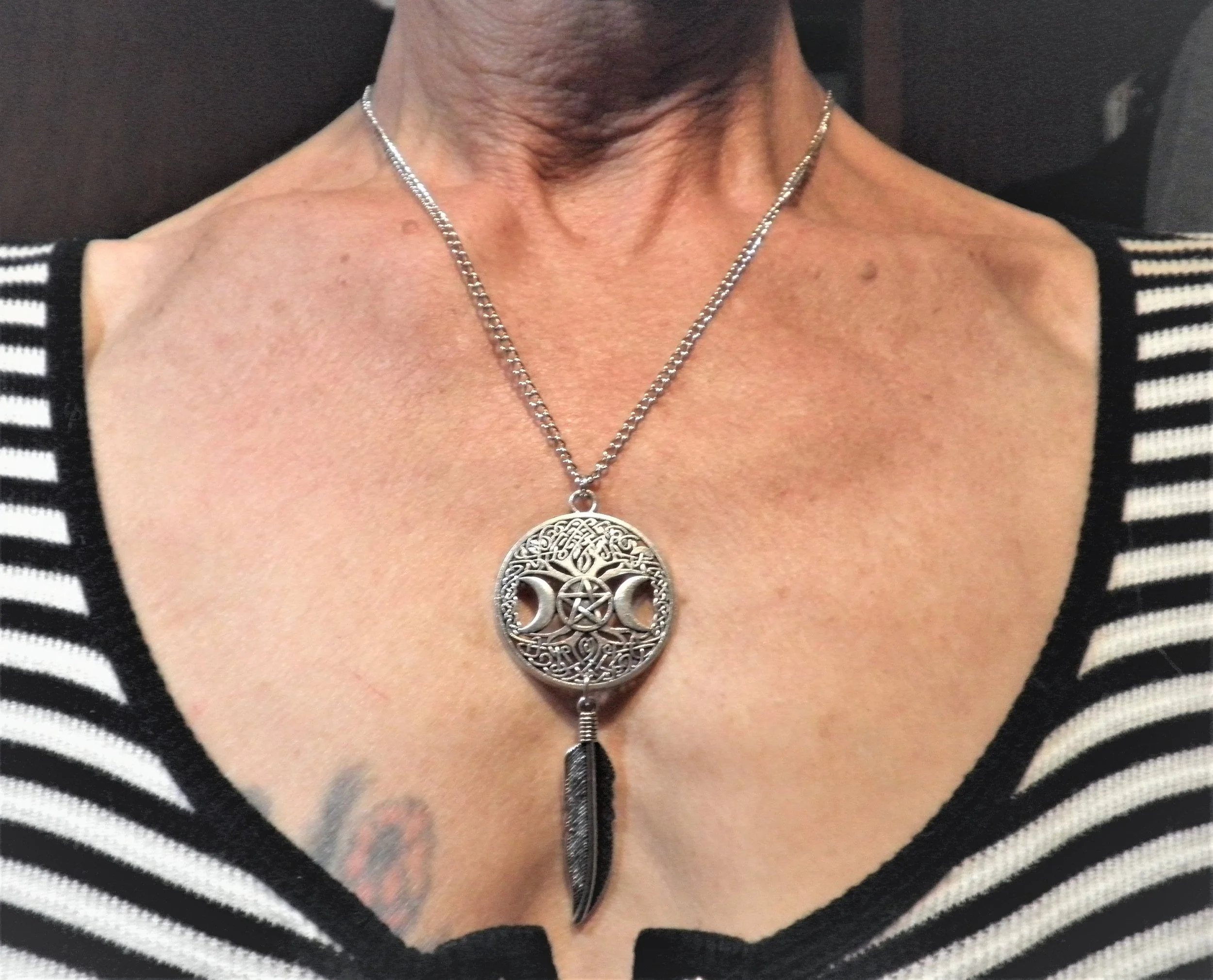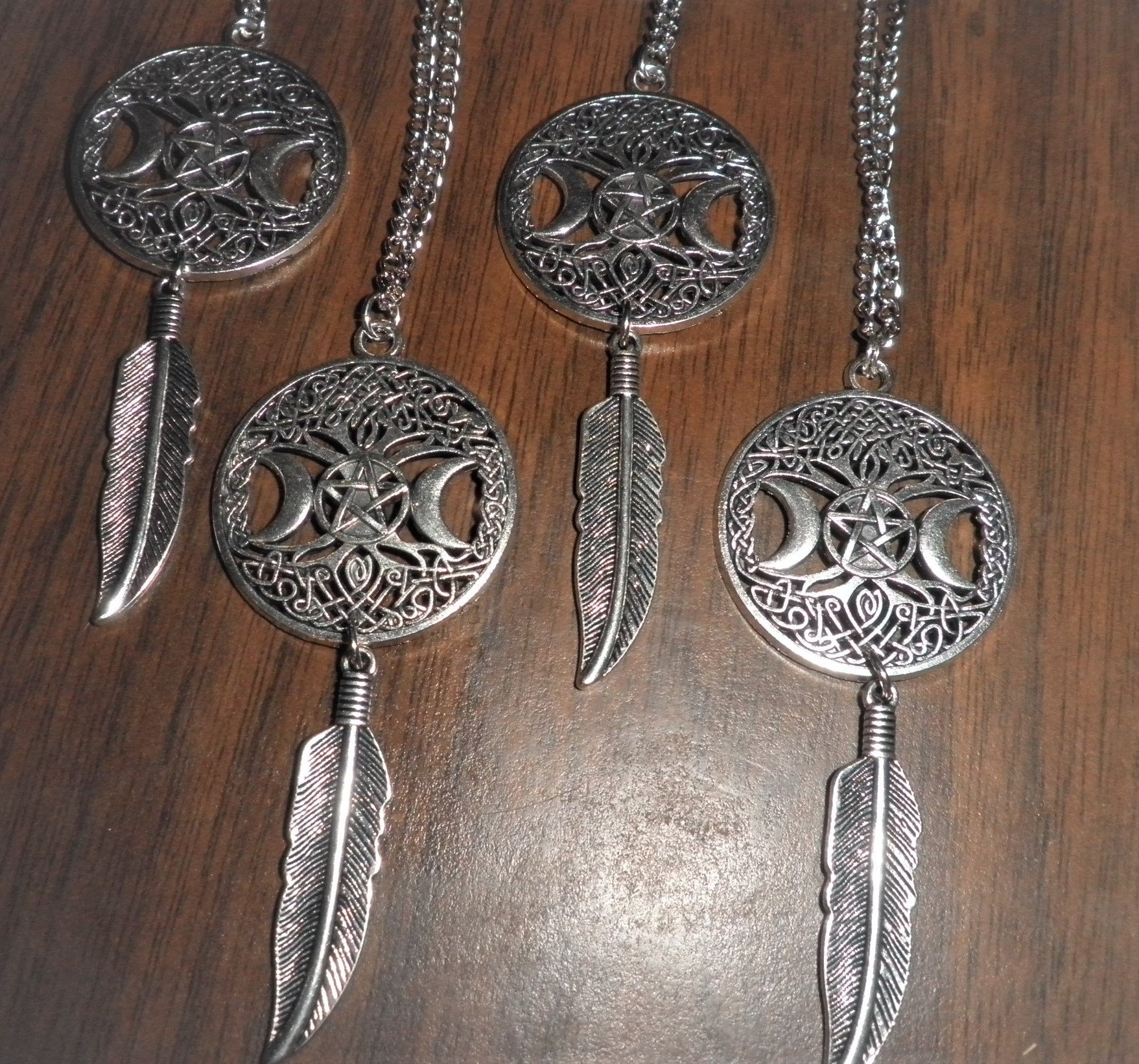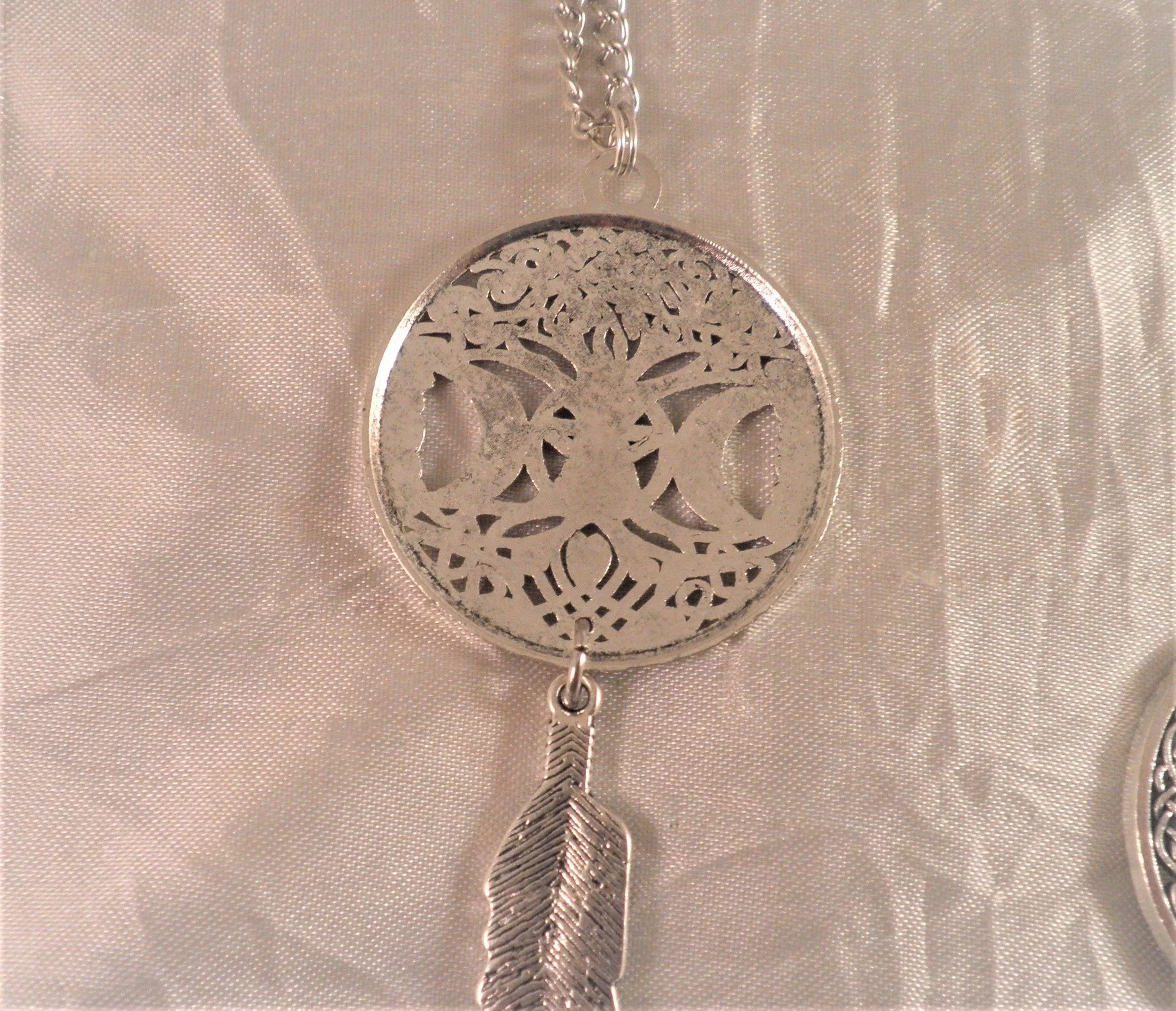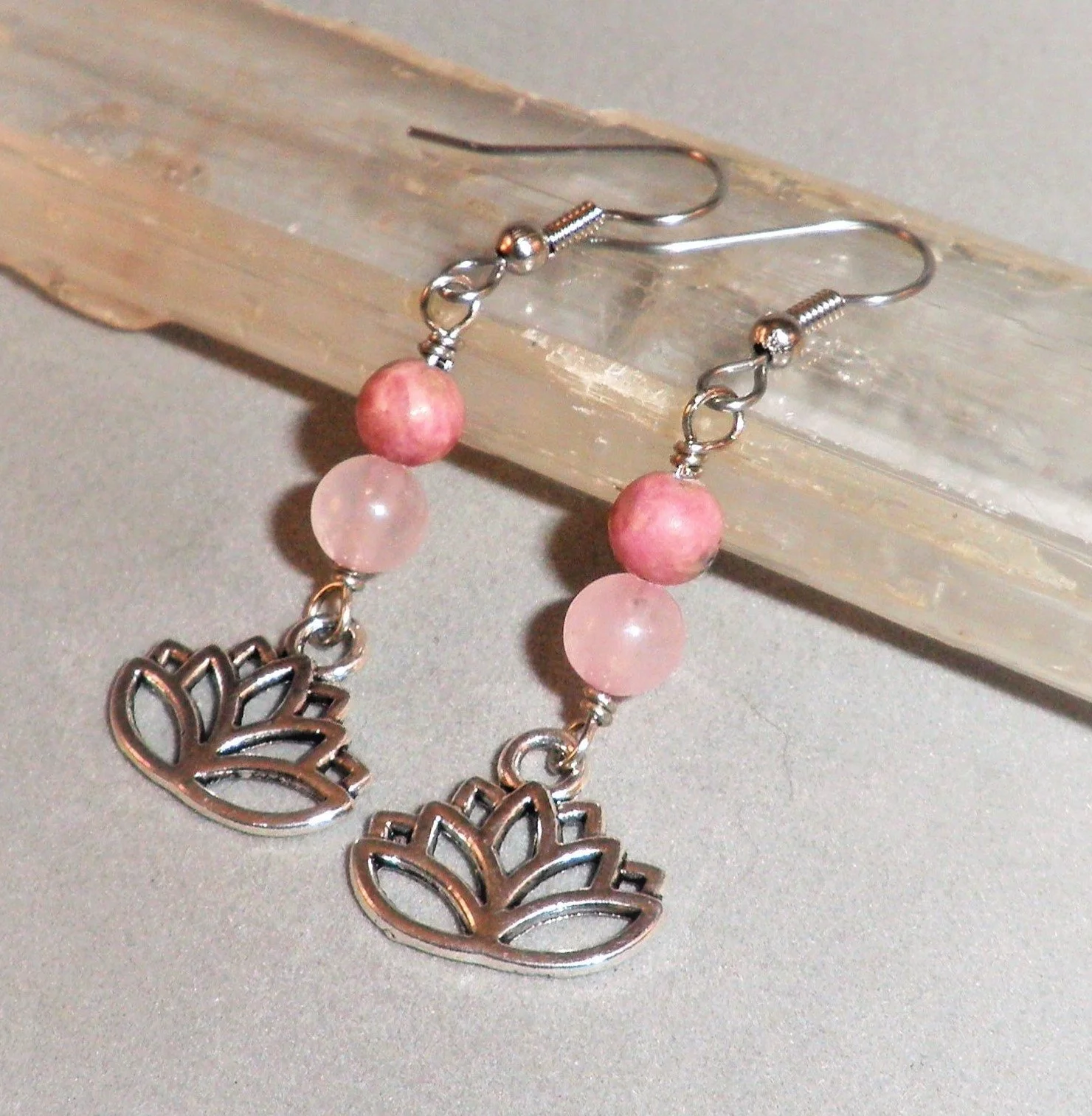 Image 1 of 10
Image 1 of 10

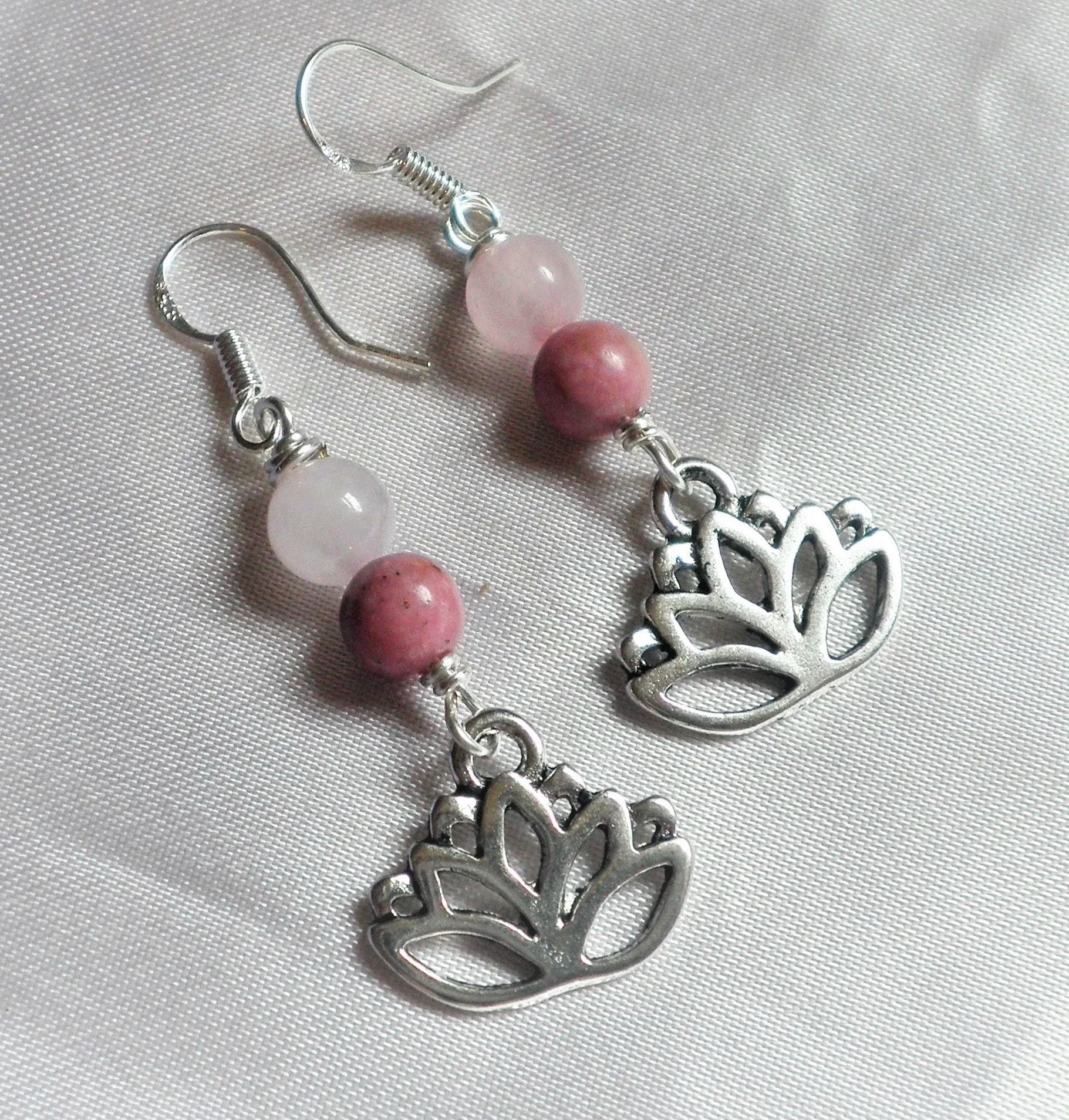 Image 2 of 10
Image 2 of 10

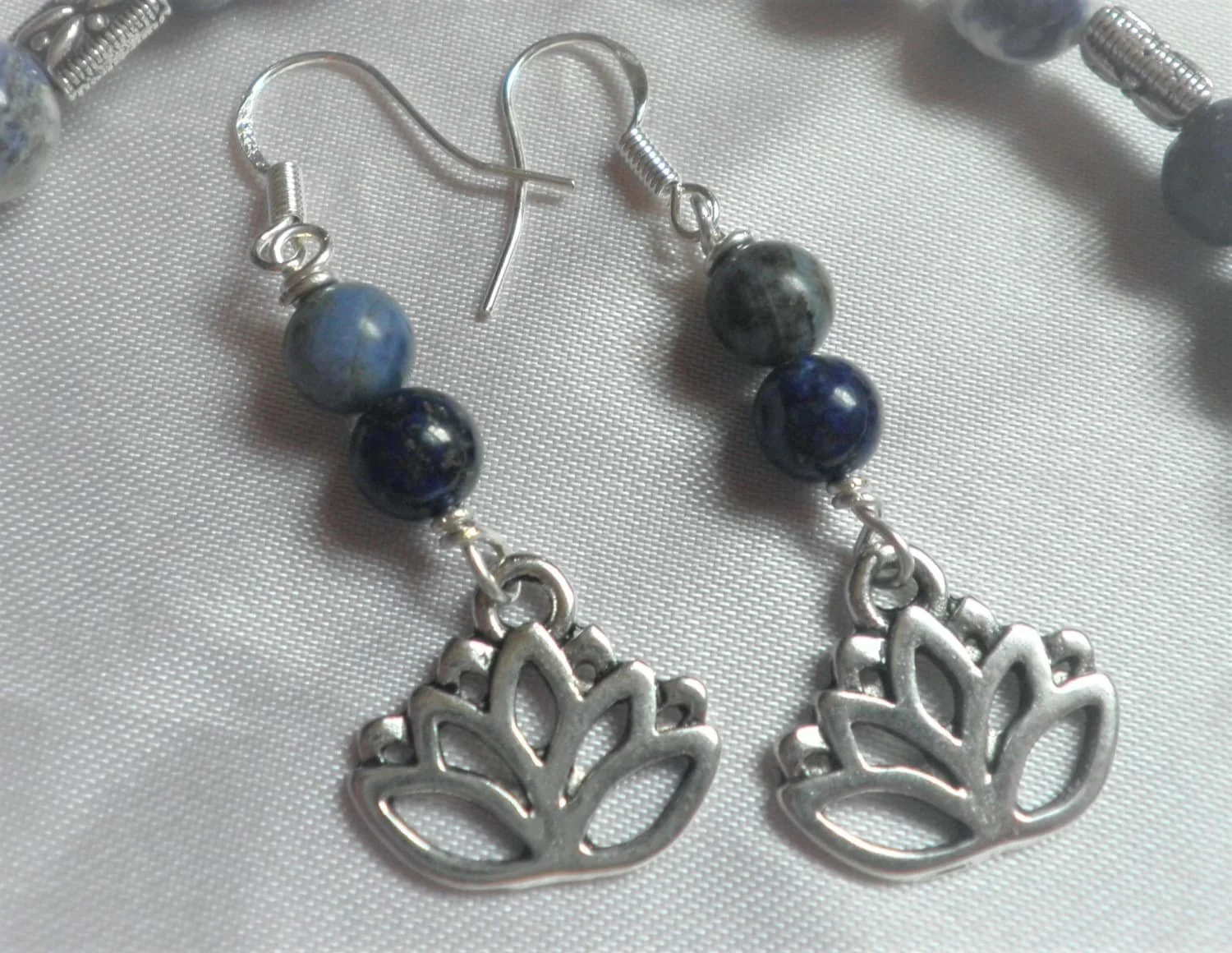 Image 3 of 10
Image 3 of 10

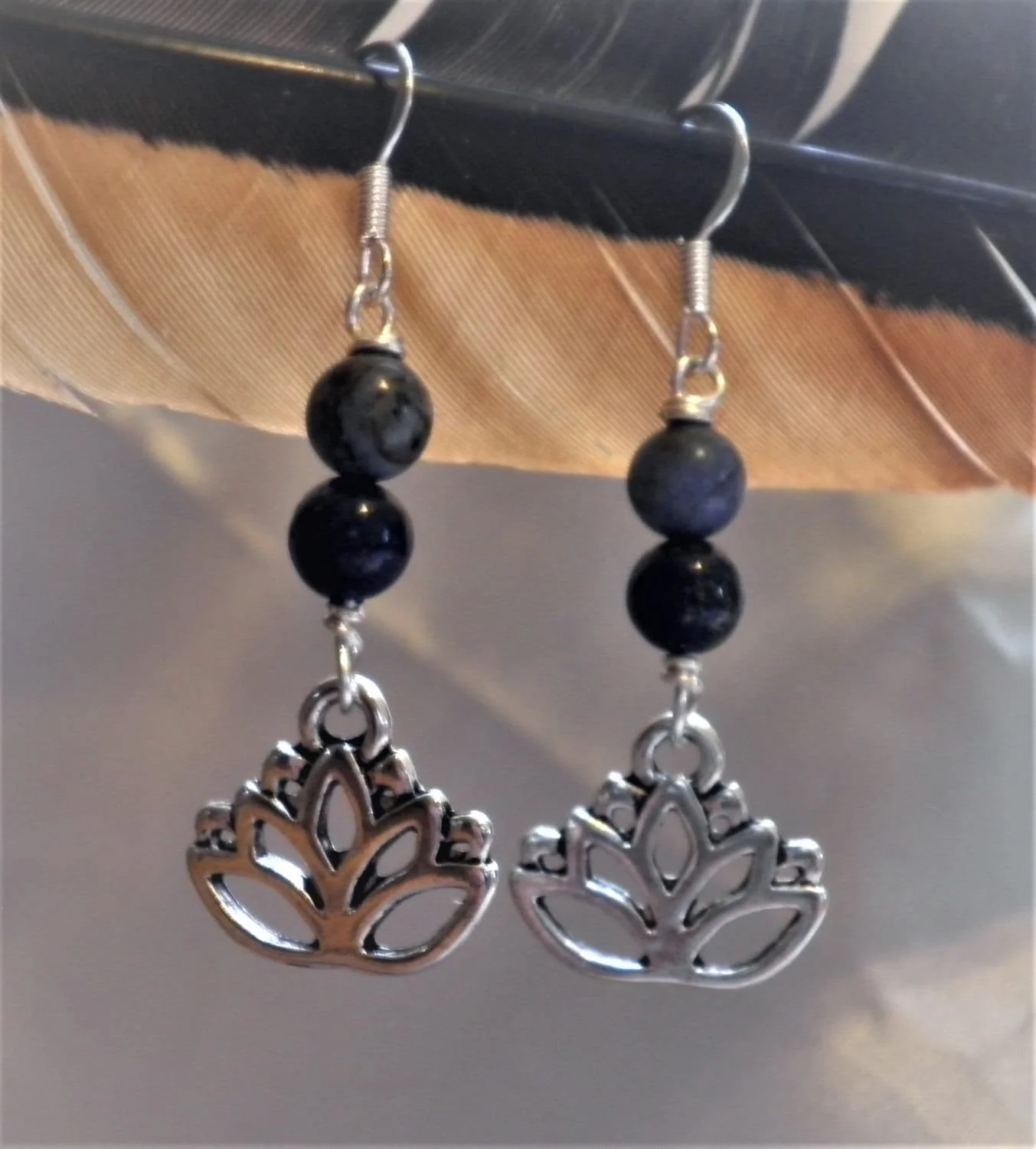 Image 4 of 10
Image 4 of 10

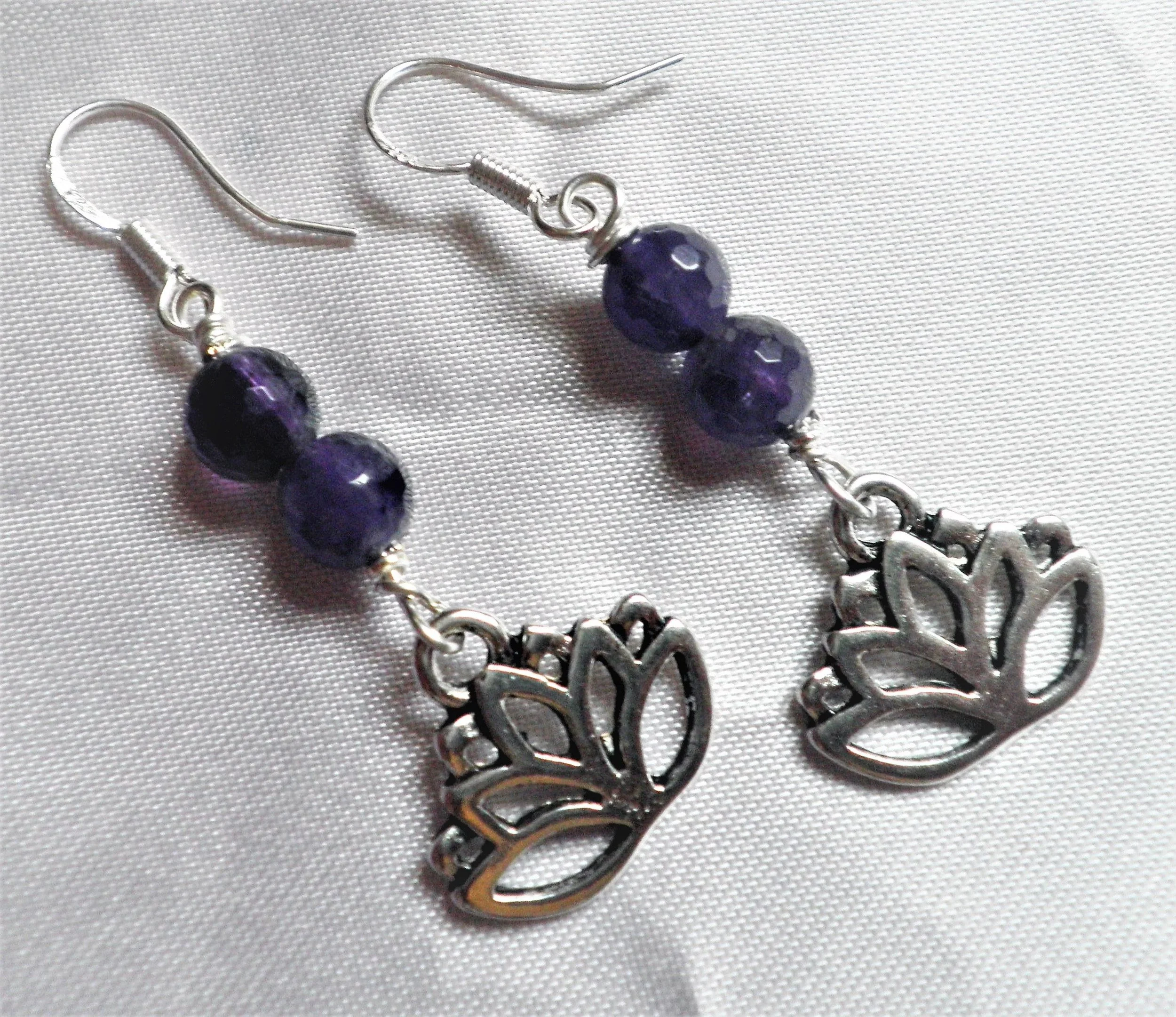 Image 5 of 10
Image 5 of 10

 Image 6 of 10
Image 6 of 10

 Image 7 of 10
Image 7 of 10

 Image 8 of 10
Image 8 of 10

 Image 9 of 10
Image 9 of 10

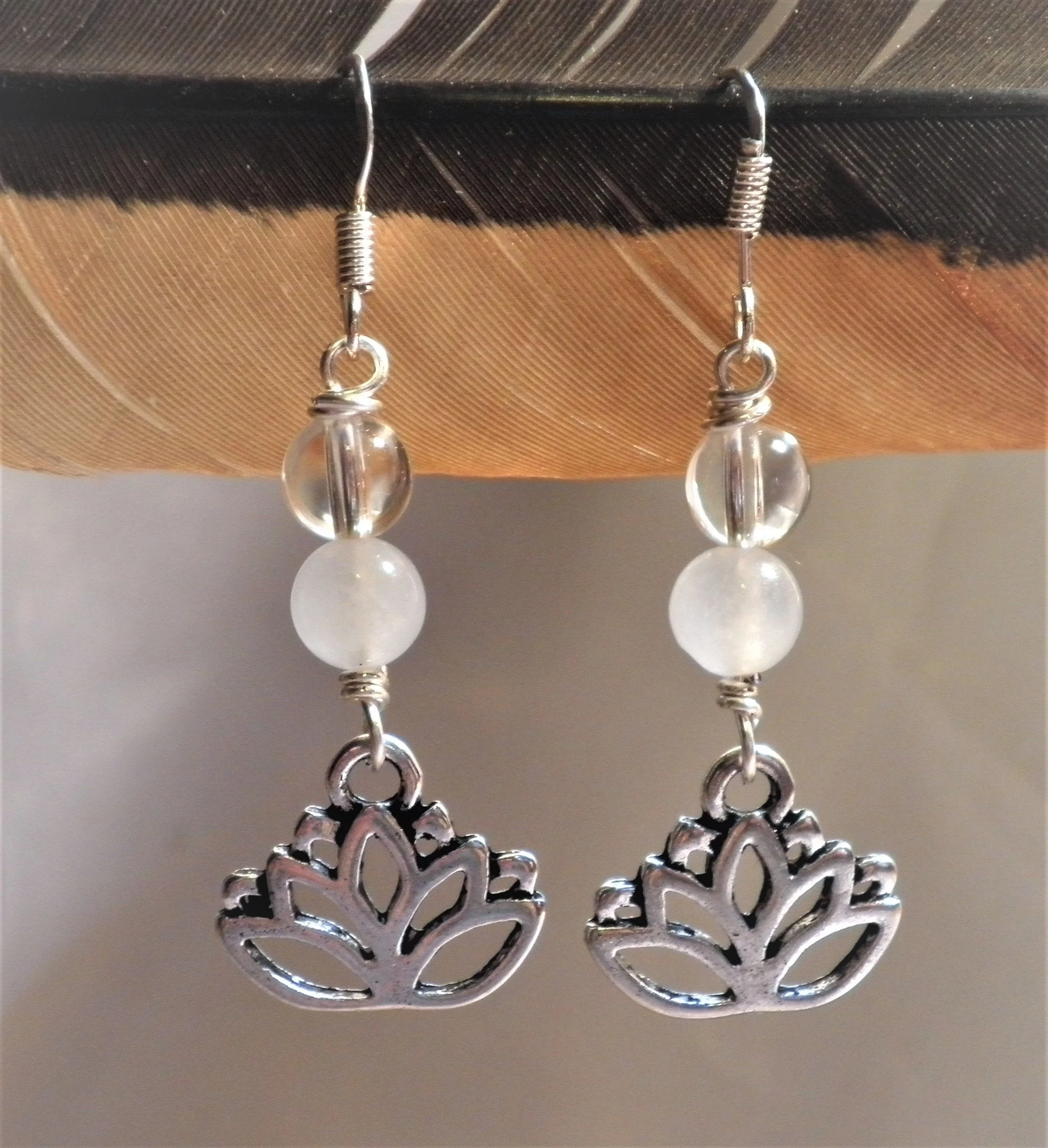 Image 10 of 10
Image 10 of 10











LOTUS FLOWER BLOSSOM Earrings- Choose Blue,Red, White, Pink or Purple In Buddhism, each of five colors symbolizes a state of mind ...
$6.05
These LOTUS FLOWER BLOSSOM Earrings are created with 6 mm genuine gemstone beads and a Silver-tone metal Lotus Blossom. They hang approx. 1 1/2 inches with Silver-tone Fish hook style wires.. It will come with the description, as seen here, highlighting the attributes they bring to your specific intention, and an Organza bag. Choose your preference!
• WHITE: Mental and spiritual purity-- White 'Jade' and Clear Quartz
• RED: The heart, compassion and love--Red Jasper and Garnet
• BLUE: Wisdom and control of the senses-- Lapis Lazuli and Sodalite
• PINK: The historical Buddha-- Rhodonite and Rose Quartz
• PURPLE: Mysticism-- Amethyst and Lilac Lepidolite
In Buddhism, color symbolism is used in a wide variety of fascinating ways in Buddhist art and ritual, especially in Tibetan Buddhism, each of five colors (pancha-varna) symbolizes a state of mind, a celestial Buddha, a part of the body, a part of the mantra word Hum, or a natural element. (Blue and black are sometimes interchangeable.)
It is believed that by meditating on the individual colors, which contain their respective essences and are associated with a particular Buddha or Bodhisattva, and spiritual transformations can be achieved.
PINK LOTUS (Skt. padma; Tib. pad ma dmar po): Sometimes it is confused with the white lotus but this is the lotus of the historical Buddha. When open, its eight petals are symbolic of the eight fold path of the Buddhism. This the supreme lotus, generally reserved for the highest deity. Thus naturally it is associated with the Great Buddha himself. It is regarded as the flower of supreme importance and is considered as the true lotus flower of Buddha. Sometimes it is confused with the white lotus ,this is the lotus of the historical Buddha. When open, its eight petals are symbolic of the eight fold path of the Buddhism.
PURPLE LOTUS signifies the mystical aspects of Buddhist mysticism and obscure sects. When open, its eight petals are symbolic of the eight fold path of the Buddhism
This is the mystic lotus, represented only in images belonging to a few esoteric sects. The flowers may be in full bloom and reveal their heart, or in a bud.
They may be supported by a simple stem, a triple stem (symbolizing the three divisions of Garbhadhatu: Vairocana, lotus and vajra), or a quintuple stem (symbolizing the Five Knowledges of Vajradhatu). The eight petals represent the Noble Eightfold Path and the eight principal acolyte deities of the central deity on the mandalas.
The flowers may also be depicted presented in a cup or on a tray, as a symbol of homage.
BLUE LOTUS- (Skt. utpala; Tib. ut pa la): This is a symbol of the victory of the spirit over the senses, and signifies the wisdom of knowledge. Not surprisingly, it is the preferred flower of Manjushri, the bodhisattva of wisdom. It is always represented as a partially opened bud, and (unlike the red lotus) its center is never seen. It is the lotus of Manjusri, and also one of the attributes of Prajnaparamita, the embodiment of the 'perfection of wisdom'.
In Buddhism both light and dark shades of blue color are important. It represents: Eternity, truth, devotion, faith, purity, chastity, peace, spiritual and intellectual life - these are some of the associations that appear in many different cultures. All express a general feeling that blue is the coolest, most detached and least material of all hues.
The Virgin Mary and Christ are often shown wearing blue in Christian art, and it is the attribute of many sky gods including Amun in Egypt, the Sumerian Great Mother, the Greek Zeus (Jupiter to the Romans), the Hindu Indra, Vishnu and his blue-skinned incarnation, Krishna.
The 'Blue Buddha', also known as the Buddha of Medicine or Healing. The most distinctive feature of this Medicine Buddha is his color, the deep blue of lapis lazuli.
Color--Blue
General Meanings --coolness, infinity, ascension, purity, healing
Seen In: --turquoise, lapis lazuli (Sodalite)
Emotion, Action --killing, anger
Transforms:--anger into mirror-like wisdom
Buddha---Akshobhya
Part of Hum --the dot (drop) on the crescent
Body Part-- ears
Element--air
WHITE LOTUS (Skt. pundarika; Tib. pad ma dkar po): This symbolizes Bodhi, the state of total mental purity and spiritual perfection, and the pacification of our nature.
It generally has eight petals corresponding to the Noble Eightfold Path of the Good Law.
It is the lotus found at the heart of the Garbhadhatu Mandala, being the womb or embryo of the world.
It is characteristic of the esoteric sects, and the lotus of the Buddhas.
It is associated with the White Tara and proclaims her perfect nature, a quality which is reinforced by the color of her body.
Summarized meaning of the main color symbols in Buddhism.
Color --White
General Meanings -learning, knowledge, purity, longevity
Seen In: -White Tara, white elephant
Emotion, Action -rest and thinking
Transforms:-delusion of ignorance into wisdom of reality
Buddha--Vairocana
Part of "Hum"- the crescent
Body Part -eyes
Element--water
RED LOTUS (Skt. kamala; Tib: pad ma chu skyes): This signifies the original nature and purity of the heart (hrdya). ). It is the lotus of love, compassion, passion and all other qualities of the heart. It is the flower of Avalokiteshvara, the bodhisattva of compassion.
Summarized meaning of the main color symbols in Buddhism.
Color --Red
General Meanings -life force, preservation, the sacred, blood, fire
Seen In: -coral, red thangkas
Emotion, Action -subjugation and summoning
Transforms:-delusion of attachment into the wisdom of discernment
Buddha--Amitabha
Part of "Hum"- syllable 'ha'
Body Part -tongue
Element--fire
TO HELP OUR LITTLE PLANET-GAIA-MOST ITEMS ARE SENT IN A UNBLEACHED POST CONSUMER -RECYCLED SHIPPING ENVELOPE! Plus as old supplies run out, I am using more sustainable packaging...Eliminating PLASTIC!
• WHITE: Mental and spiritual purity-- White 'Jade' and Clear Quartz
• RED: The heart, compassion and love--Red Jasper and Garnet
• BLUE: Wisdom and control of the senses-- Lapis Lazuli and Sodalite
• PINK: The historical Buddha-- Rhodonite and Rose Quartz
• PURPLE: Mysticism-- Amethyst and Lilac Lepidolite
In Buddhism, color symbolism is used in a wide variety of fascinating ways in Buddhist art and ritual, especially in Tibetan Buddhism, each of five colors (pancha-varna) symbolizes a state of mind, a celestial Buddha, a part of the body, a part of the mantra word Hum, or a natural element. (Blue and black are sometimes interchangeable.)
It is believed that by meditating on the individual colors, which contain their respective essences and are associated with a particular Buddha or Bodhisattva, and spiritual transformations can be achieved.
PINK LOTUS (Skt. padma; Tib. pad ma dmar po): Sometimes it is confused with the white lotus but this is the lotus of the historical Buddha. When open, its eight petals are symbolic of the eight fold path of the Buddhism. This the supreme lotus, generally reserved for the highest deity. Thus naturally it is associated with the Great Buddha himself. It is regarded as the flower of supreme importance and is considered as the true lotus flower of Buddha. Sometimes it is confused with the white lotus ,this is the lotus of the historical Buddha. When open, its eight petals are symbolic of the eight fold path of the Buddhism.
PURPLE LOTUS signifies the mystical aspects of Buddhist mysticism and obscure sects. When open, its eight petals are symbolic of the eight fold path of the Buddhism
This is the mystic lotus, represented only in images belonging to a few esoteric sects. The flowers may be in full bloom and reveal their heart, or in a bud.
They may be supported by a simple stem, a triple stem (symbolizing the three divisions of Garbhadhatu: Vairocana, lotus and vajra), or a quintuple stem (symbolizing the Five Knowledges of Vajradhatu). The eight petals represent the Noble Eightfold Path and the eight principal acolyte deities of the central deity on the mandalas.
The flowers may also be depicted presented in a cup or on a tray, as a symbol of homage.
BLUE LOTUS- (Skt. utpala; Tib. ut pa la): This is a symbol of the victory of the spirit over the senses, and signifies the wisdom of knowledge. Not surprisingly, it is the preferred flower of Manjushri, the bodhisattva of wisdom. It is always represented as a partially opened bud, and (unlike the red lotus) its center is never seen. It is the lotus of Manjusri, and also one of the attributes of Prajnaparamita, the embodiment of the 'perfection of wisdom'.
In Buddhism both light and dark shades of blue color are important. It represents: Eternity, truth, devotion, faith, purity, chastity, peace, spiritual and intellectual life - these are some of the associations that appear in many different cultures. All express a general feeling that blue is the coolest, most detached and least material of all hues.
The Virgin Mary and Christ are often shown wearing blue in Christian art, and it is the attribute of many sky gods including Amun in Egypt, the Sumerian Great Mother, the Greek Zeus (Jupiter to the Romans), the Hindu Indra, Vishnu and his blue-skinned incarnation, Krishna.
The 'Blue Buddha', also known as the Buddha of Medicine or Healing. The most distinctive feature of this Medicine Buddha is his color, the deep blue of lapis lazuli.
Color--Blue
General Meanings --coolness, infinity, ascension, purity, healing
Seen In: --turquoise, lapis lazuli (Sodalite)
Emotion, Action --killing, anger
Transforms:--anger into mirror-like wisdom
Buddha---Akshobhya
Part of Hum --the dot (drop) on the crescent
Body Part-- ears
Element--air
WHITE LOTUS (Skt. pundarika; Tib. pad ma dkar po): This symbolizes Bodhi, the state of total mental purity and spiritual perfection, and the pacification of our nature.
It generally has eight petals corresponding to the Noble Eightfold Path of the Good Law.
It is the lotus found at the heart of the Garbhadhatu Mandala, being the womb or embryo of the world.
It is characteristic of the esoteric sects, and the lotus of the Buddhas.
It is associated with the White Tara and proclaims her perfect nature, a quality which is reinforced by the color of her body.
Summarized meaning of the main color symbols in Buddhism.
Color --White
General Meanings -learning, knowledge, purity, longevity
Seen In: -White Tara, white elephant
Emotion, Action -rest and thinking
Transforms:-delusion of ignorance into wisdom of reality
Buddha--Vairocana
Part of "Hum"- the crescent
Body Part -eyes
Element--water
RED LOTUS (Skt. kamala; Tib: pad ma chu skyes): This signifies the original nature and purity of the heart (hrdya). ). It is the lotus of love, compassion, passion and all other qualities of the heart. It is the flower of Avalokiteshvara, the bodhisattva of compassion.
Summarized meaning of the main color symbols in Buddhism.
Color --Red
General Meanings -life force, preservation, the sacred, blood, fire
Seen In: -coral, red thangkas
Emotion, Action -subjugation and summoning
Transforms:-delusion of attachment into the wisdom of discernment
Buddha--Amitabha
Part of "Hum"- syllable 'ha'
Body Part -tongue
Element--fire
TO HELP OUR LITTLE PLANET-GAIA-MOST ITEMS ARE SENT IN A UNBLEACHED POST CONSUMER -RECYCLED SHIPPING ENVELOPE! Plus as old supplies run out, I am using more sustainable packaging...Eliminating PLASTIC!
Chose gemstone Preference:
These LOTUS FLOWER BLOSSOM Earrings are created with 6 mm genuine gemstone beads and a Silver-tone metal Lotus Blossom. They hang approx. 1 1/2 inches with Silver-tone Fish hook style wires.. It will come with the description, as seen here, highlighting the attributes they bring to your specific intention, and an Organza bag. Choose your preference!
• WHITE: Mental and spiritual purity-- White 'Jade' and Clear Quartz
• RED: The heart, compassion and love--Red Jasper and Garnet
• BLUE: Wisdom and control of the senses-- Lapis Lazuli and Sodalite
• PINK: The historical Buddha-- Rhodonite and Rose Quartz
• PURPLE: Mysticism-- Amethyst and Lilac Lepidolite
In Buddhism, color symbolism is used in a wide variety of fascinating ways in Buddhist art and ritual, especially in Tibetan Buddhism, each of five colors (pancha-varna) symbolizes a state of mind, a celestial Buddha, a part of the body, a part of the mantra word Hum, or a natural element. (Blue and black are sometimes interchangeable.)
It is believed that by meditating on the individual colors, which contain their respective essences and are associated with a particular Buddha or Bodhisattva, and spiritual transformations can be achieved.
PINK LOTUS (Skt. padma; Tib. pad ma dmar po): Sometimes it is confused with the white lotus but this is the lotus of the historical Buddha. When open, its eight petals are symbolic of the eight fold path of the Buddhism. This the supreme lotus, generally reserved for the highest deity. Thus naturally it is associated with the Great Buddha himself. It is regarded as the flower of supreme importance and is considered as the true lotus flower of Buddha. Sometimes it is confused with the white lotus ,this is the lotus of the historical Buddha. When open, its eight petals are symbolic of the eight fold path of the Buddhism.
PURPLE LOTUS signifies the mystical aspects of Buddhist mysticism and obscure sects. When open, its eight petals are symbolic of the eight fold path of the Buddhism
This is the mystic lotus, represented only in images belonging to a few esoteric sects. The flowers may be in full bloom and reveal their heart, or in a bud.
They may be supported by a simple stem, a triple stem (symbolizing the three divisions of Garbhadhatu: Vairocana, lotus and vajra), or a quintuple stem (symbolizing the Five Knowledges of Vajradhatu). The eight petals represent the Noble Eightfold Path and the eight principal acolyte deities of the central deity on the mandalas.
The flowers may also be depicted presented in a cup or on a tray, as a symbol of homage.
BLUE LOTUS- (Skt. utpala; Tib. ut pa la): This is a symbol of the victory of the spirit over the senses, and signifies the wisdom of knowledge. Not surprisingly, it is the preferred flower of Manjushri, the bodhisattva of wisdom. It is always represented as a partially opened bud, and (unlike the red lotus) its center is never seen. It is the lotus of Manjusri, and also one of the attributes of Prajnaparamita, the embodiment of the 'perfection of wisdom'.
In Buddhism both light and dark shades of blue color are important. It represents: Eternity, truth, devotion, faith, purity, chastity, peace, spiritual and intellectual life - these are some of the associations that appear in many different cultures. All express a general feeling that blue is the coolest, most detached and least material of all hues.
The Virgin Mary and Christ are often shown wearing blue in Christian art, and it is the attribute of many sky gods including Amun in Egypt, the Sumerian Great Mother, the Greek Zeus (Jupiter to the Romans), the Hindu Indra, Vishnu and his blue-skinned incarnation, Krishna.
The 'Blue Buddha', also known as the Buddha of Medicine or Healing. The most distinctive feature of this Medicine Buddha is his color, the deep blue of lapis lazuli.
Color--Blue
General Meanings --coolness, infinity, ascension, purity, healing
Seen In: --turquoise, lapis lazuli (Sodalite)
Emotion, Action --killing, anger
Transforms:--anger into mirror-like wisdom
Buddha---Akshobhya
Part of Hum --the dot (drop) on the crescent
Body Part-- ears
Element--air
WHITE LOTUS (Skt. pundarika; Tib. pad ma dkar po): This symbolizes Bodhi, the state of total mental purity and spiritual perfection, and the pacification of our nature.
It generally has eight petals corresponding to the Noble Eightfold Path of the Good Law.
It is the lotus found at the heart of the Garbhadhatu Mandala, being the womb or embryo of the world.
It is characteristic of the esoteric sects, and the lotus of the Buddhas.
It is associated with the White Tara and proclaims her perfect nature, a quality which is reinforced by the color of her body.
Summarized meaning of the main color symbols in Buddhism.
Color --White
General Meanings -learning, knowledge, purity, longevity
Seen In: -White Tara, white elephant
Emotion, Action -rest and thinking
Transforms:-delusion of ignorance into wisdom of reality
Buddha--Vairocana
Part of "Hum"- the crescent
Body Part -eyes
Element--water
RED LOTUS (Skt. kamala; Tib: pad ma chu skyes): This signifies the original nature and purity of the heart (hrdya). ). It is the lotus of love, compassion, passion and all other qualities of the heart. It is the flower of Avalokiteshvara, the bodhisattva of compassion.
Summarized meaning of the main color symbols in Buddhism.
Color --Red
General Meanings -life force, preservation, the sacred, blood, fire
Seen In: -coral, red thangkas
Emotion, Action -subjugation and summoning
Transforms:-delusion of attachment into the wisdom of discernment
Buddha--Amitabha
Part of "Hum"- syllable 'ha'
Body Part -tongue
Element--fire
TO HELP OUR LITTLE PLANET-GAIA-MOST ITEMS ARE SENT IN A UNBLEACHED POST CONSUMER -RECYCLED SHIPPING ENVELOPE! Plus as old supplies run out, I am using more sustainable packaging...Eliminating PLASTIC!
• WHITE: Mental and spiritual purity-- White 'Jade' and Clear Quartz
• RED: The heart, compassion and love--Red Jasper and Garnet
• BLUE: Wisdom and control of the senses-- Lapis Lazuli and Sodalite
• PINK: The historical Buddha-- Rhodonite and Rose Quartz
• PURPLE: Mysticism-- Amethyst and Lilac Lepidolite
In Buddhism, color symbolism is used in a wide variety of fascinating ways in Buddhist art and ritual, especially in Tibetan Buddhism, each of five colors (pancha-varna) symbolizes a state of mind, a celestial Buddha, a part of the body, a part of the mantra word Hum, or a natural element. (Blue and black are sometimes interchangeable.)
It is believed that by meditating on the individual colors, which contain their respective essences and are associated with a particular Buddha or Bodhisattva, and spiritual transformations can be achieved.
PINK LOTUS (Skt. padma; Tib. pad ma dmar po): Sometimes it is confused with the white lotus but this is the lotus of the historical Buddha. When open, its eight petals are symbolic of the eight fold path of the Buddhism. This the supreme lotus, generally reserved for the highest deity. Thus naturally it is associated with the Great Buddha himself. It is regarded as the flower of supreme importance and is considered as the true lotus flower of Buddha. Sometimes it is confused with the white lotus ,this is the lotus of the historical Buddha. When open, its eight petals are symbolic of the eight fold path of the Buddhism.
PURPLE LOTUS signifies the mystical aspects of Buddhist mysticism and obscure sects. When open, its eight petals are symbolic of the eight fold path of the Buddhism
This is the mystic lotus, represented only in images belonging to a few esoteric sects. The flowers may be in full bloom and reveal their heart, or in a bud.
They may be supported by a simple stem, a triple stem (symbolizing the three divisions of Garbhadhatu: Vairocana, lotus and vajra), or a quintuple stem (symbolizing the Five Knowledges of Vajradhatu). The eight petals represent the Noble Eightfold Path and the eight principal acolyte deities of the central deity on the mandalas.
The flowers may also be depicted presented in a cup or on a tray, as a symbol of homage.
BLUE LOTUS- (Skt. utpala; Tib. ut pa la): This is a symbol of the victory of the spirit over the senses, and signifies the wisdom of knowledge. Not surprisingly, it is the preferred flower of Manjushri, the bodhisattva of wisdom. It is always represented as a partially opened bud, and (unlike the red lotus) its center is never seen. It is the lotus of Manjusri, and also one of the attributes of Prajnaparamita, the embodiment of the 'perfection of wisdom'.
In Buddhism both light and dark shades of blue color are important. It represents: Eternity, truth, devotion, faith, purity, chastity, peace, spiritual and intellectual life - these are some of the associations that appear in many different cultures. All express a general feeling that blue is the coolest, most detached and least material of all hues.
The Virgin Mary and Christ are often shown wearing blue in Christian art, and it is the attribute of many sky gods including Amun in Egypt, the Sumerian Great Mother, the Greek Zeus (Jupiter to the Romans), the Hindu Indra, Vishnu and his blue-skinned incarnation, Krishna.
The 'Blue Buddha', also known as the Buddha of Medicine or Healing. The most distinctive feature of this Medicine Buddha is his color, the deep blue of lapis lazuli.
Color--Blue
General Meanings --coolness, infinity, ascension, purity, healing
Seen In: --turquoise, lapis lazuli (Sodalite)
Emotion, Action --killing, anger
Transforms:--anger into mirror-like wisdom
Buddha---Akshobhya
Part of Hum --the dot (drop) on the crescent
Body Part-- ears
Element--air
WHITE LOTUS (Skt. pundarika; Tib. pad ma dkar po): This symbolizes Bodhi, the state of total mental purity and spiritual perfection, and the pacification of our nature.
It generally has eight petals corresponding to the Noble Eightfold Path of the Good Law.
It is the lotus found at the heart of the Garbhadhatu Mandala, being the womb or embryo of the world.
It is characteristic of the esoteric sects, and the lotus of the Buddhas.
It is associated with the White Tara and proclaims her perfect nature, a quality which is reinforced by the color of her body.
Summarized meaning of the main color symbols in Buddhism.
Color --White
General Meanings -learning, knowledge, purity, longevity
Seen In: -White Tara, white elephant
Emotion, Action -rest and thinking
Transforms:-delusion of ignorance into wisdom of reality
Buddha--Vairocana
Part of "Hum"- the crescent
Body Part -eyes
Element--water
RED LOTUS (Skt. kamala; Tib: pad ma chu skyes): This signifies the original nature and purity of the heart (hrdya). ). It is the lotus of love, compassion, passion and all other qualities of the heart. It is the flower of Avalokiteshvara, the bodhisattva of compassion.
Summarized meaning of the main color symbols in Buddhism.
Color --Red
General Meanings -life force, preservation, the sacred, blood, fire
Seen In: -coral, red thangkas
Emotion, Action -subjugation and summoning
Transforms:-delusion of attachment into the wisdom of discernment
Buddha--Amitabha
Part of "Hum"- syllable 'ha'
Body Part -tongue
Element--fire
TO HELP OUR LITTLE PLANET-GAIA-MOST ITEMS ARE SENT IN A UNBLEACHED POST CONSUMER -RECYCLED SHIPPING ENVELOPE! Plus as old supplies run out, I am using more sustainable packaging...Eliminating PLASTIC!


